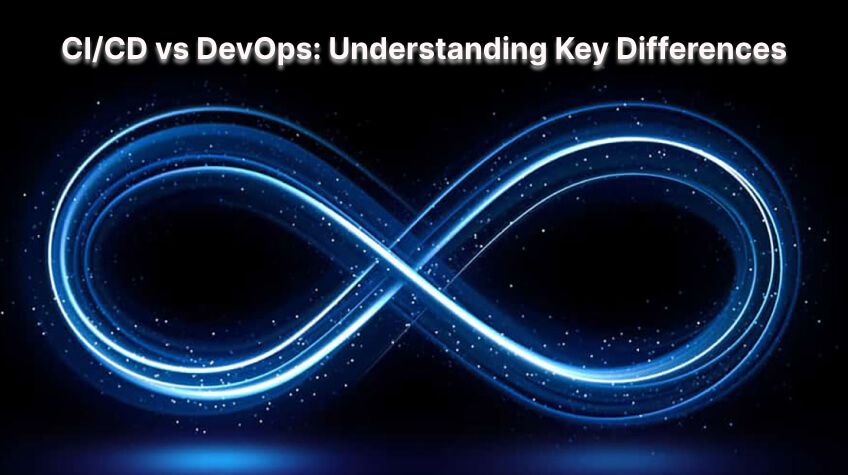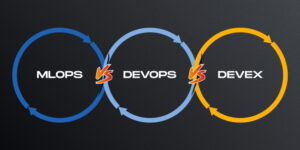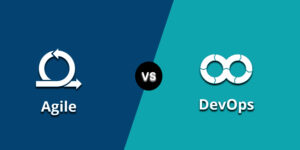
In the fast-paced realm of software development, staying ahead of the competition requires more than just writing code. It demands efficient processes for Development, Integration, and Deployment. Two popular methodologies that have emerged to address these needs are CI/CD (Continuous Integration/Continuous Deployment) and DevOps.
While they aim to improve software delivery, CI/CD and DevOps possess distinct characteristics and approaches. In this blog, we will unravel the ten critical differences between CI/CD and DevOps, shedding light on their unique features, benefits, and the ways they can be leveraged to drive success in your software development endeavors. So, let’s plunge in and research these intriguing methodologies!
What Is DevOps
‘DevOps’ goes beyond buzzwords; it represents a transformative mindset and collaborative approach to software development. It’s a cultural shift that breaks down barriers between development, operations, and other groups concerned with the software lifecycle. At its core, DevOps fosters effective communication, shared responsibility, and continuous improvement.
By leveraging automation, DevOps empowers organizations to deliver software faster, reliably, and with more elevated grades. It encourages teams to iterate, learn from failures, and reply to feedback quickly. DevOps isn’t just about technology; it’s about creating a collaborative and innovative environment where people and processes work harmoniously to achieve business objectives.
Key Benefits of DevOps
DevOps brings a plethora of benefits to organizations, revolutionizing their software delivery practices and driving business success. Firstly, it enables faster time-to-market, allowing companies to seize market opportunities swiftly. Through automation and streamlining processes, DevOps increases operational efficiency and reduces time wasted on manual interventions.
Moreover, DevOps promotes better collaboration and communication among teams, enhancing shared responsibility and breaking down silos. This leads to improved team morale and productivity. With continuous Integration, testing, and deployment, DevOps ensures higher quality software, reducing errors and enhancing customer satisfaction. Ultimately, DevOps empowers organizations to innovate, adapt to change, and stay ahead in today’s competitive landscape.
What is CI/CD
CI/CD, which stands for Continuous Integration/Continuous Deployment, is a software development approach that revolutionizes how code is built, tested, and deployed. It encompasses two interconnected processes that work seamlessly together. It is a process of merging code changes frequently into a shared repository, followed by automated building and testing to catch integration issues early on.
Unlike Continuous Integration, Continuous Deployment automates the release and deployment of the tested code changes into production environments. CI/CD fosters a culture of automation, collaboration, and rapid feedback, enabling development teams to deliver software updates more frequently, reliably, and with reduced risk of errors or conflicts. It designates companies to acquire faster time-to-market, improve software quality, and enhance overall development efficiency.
Key Benefits of CI/CD
CI/CD, or Continuous Integration/Continuous Deployment, offers a range of compelling benefits for software development teams and organizations. Firstly, it promotes faster time-to-market by automating the build, test, and deployment processes, enabling frequent and reliable releases. This dexterity permits businesses to quickly adjust to market demands and gain a competitive edge.
Secondly, CI/CD enhances software quality through continuous Integration and automated testing, catching issues early and reducing the risk of defects reaching production. It also encourages collaboration and communication among group associates, fostering a cohesive and efficient development environment. Ultimately, CI/CD streamlines workflows, increase productivity and deliver value to customers with shorter release cycles and faster feedback loops.
CI/CD Vs DevOps: Understanding 10 Key Differences
1. Focus and Scope
The critical distinction between CI/CD and DevOps lies in their focus and scope. CI/CD primarily concentrates on the development and deployment processes, aiming to automate and streamline code integration and deployment. It revolves around efficient build, test, and release cycles, allowing for rapid iteration and feedback.
On the other hand, DevOps encompasses a broader range of practices. It goes beyond development and deployment, extending to collaboration, communication, and infrastructure management. DevOps emphasizes breaking down silos between teams, fostering a culture of collaboration and shared responsibility across the entire software development lifecycle.
While CI/CD optimizes specific processes, DevOps takes a holistic approach, emphasizing the importance of cross-functional collaboration and continuous organizational improvement.
2. Goals
The goals of CI/CD and DevOps showcase their distinct focuses and objectives. CI/CD primarily aims to automate and streamline the Integration and deployment of code changes. It seeks to enhance the efficiency of development processes, reduce manual errors, and ensure that software updates are seamlessly integrated and deployed.
In contrast, DevOps has a broader set of goals. It goes beyond the specific aspects of development and deployment and focuses on breaking down silos between teams. DevOps aims to foster collaboration, communication, and shared responsibility among stakeholders in the software development lifecycle. It strives to improve the entire process, from planning and coding to testing, deployment, and ongoing maintenance. DevOps aims to create a continuous improvement and dexterity culture at all levels.
3. Automation
One key difference between CI/CD and DevOps lies in the extent of automation they emphasize. CI/CD primarily automates the build, test, and deployment processes. It streamlines these specific aspects of software development, ensuring that code changes are seamlessly integrated, tested, and deployed with minimal manual effort.
In contrast, DevOps takes automation further by extending it to areas beyond development. DevOps emphasizes automating infrastructure provisioning, configuration management, and monitoring processes. This broader automation approach enables organizations to achieve infrastructure as code, where infrastructure setups and configurations are automated and version-controlled, leading to consistent and reproducible environments.
DevOps facilitates faster and more efficient infrastructure management by going beyond development automation, enabling teams to deliver software with incredible speed, reliability, and scalability.
4. Culture
Regarding culture, CI/CD and DevOps exhibit notable differences. CI/CD primarily stresses the association between development and operations teams. It aims to bridge the gap between these traditionally separate teams, fostering effective communication and alignment in the software delivery process.
In contrast, DevOps goes beyond the boundaries of development and operations. It encourages cross-functional collaboration and involvement from various stakeholders, including developers, operations, quality assurance, security, and even business teams. DevOps promotes a cultural shift where teams work together towards shared goals, breaking down silos and embracing a collaborative mindset.
By fostering cross-functional collaboration, DevOps creates a culture of collective responsibility, mutual respect, and continuous learning, enhancing productivity, innovation, and overall success in software delivery.
5. Collaboration
Collaboration is a critical aspect of both CI/CD and DevOps, but they differ in terms of the scope and breadth of collaboration involved. CI/CD primarily focuses on collaboration between development and deployment teams. It ensures seamless coordination between these two functions, allowing for efficient code integration and deployment processes.
In contrast, DevOps takes collaboration to a broader level, encompassing the entire software development lifecycle. It promotes cooperation between development and operations and includes planning, testing, and other key stakeholders such as quality assurance and business teams. DevOps encourages cross-functional collaboration, ensuring all teams work together throughout the software lifecycle to achieve shared goals of continuous improvement, faster delivery, and higher-quality software.
By promoting collaboration at every stage, DevOps fosters a culture of teamwork, knowledge sharing, and collective ownership, leading to improved efficiency, reduced errors, and, ultimately, better software outcomes.
6. Tools and Technologies
Regarding tools and technologies, CI/CD and DevOps differ in their areas of focus and the toolsets they rely on. CI/CD heavily relies on tools such as version control systems (e.g., Git), build servers (e.g., Jenkins), and continuous integration platforms (e.g., Travis CI, CircleCI). These tools automate code integration, building, testing, and deployment processes, enabling seamless and efficient software delivery.
DevOps, conversely, encompasses a broader set of practices and utilizes a wide range of tools. In addition to the CI/CD tools, DevOps emphasizes infrastructure automation tools like Ansible, Puppet, or Terraform, which enable automated provisioning and managing infrastructure resources. Configuration management tools like Chef or SaltStack help keep endless configurations across various backgrounds.
Monitoring and observability tools like Prometheus, ELK stack, Datadog or alternatives aid in real-time visibility and performance tracking. Collaboration tools like Slack or Jira facilitate effective communication and teamwork among teams. By leveraging a comprehensive set of tools, DevOps enables organizations to automate development processes, infrastructure management, monitoring, and collaboration, promoting efficiency, scalability, and cross-functional collaboration.
7. Deployment Frequency
Regarding deployment frequency, both CI/CD and DevOps emphasize the importance of frequent deployments. CI/CD enables organizations to achieve rapid iteration and feedback by automating the deployment process. It focuses on breaking down significant code changes into smaller, manageable increments that can be deployed more frequently. This allows for quick validation, bug detection, and new features and enhancements delivery.
On the other hand, DevOps takes a holistic approach to deployment frequency. While it promotes frequent deployments, it also emphasizes the need for stability, reliability, security, and speed. DevOps practices ensure the deployment process is well-tested, adequately monitored, and adheres to security and compliance standards. It seeks to balance delivering updates quickly and supplying a steady and protected production environment.
By considering both speed and stability, DevOps enables organizations to deploy changes frequently while maintaining their systems’ overall reliability and security.
8. Scope of Responsibility
The scope of responsibility is another key differentiator between CI/CD and DevOps. CI/CD primarily focuses on the development and deployment of pipelines. It ensures smooth Integration, automated testing, and seamless deployment of code changes. CI/CD’s primary goal is to optimize the delivery process, from code commit to production release.
In contrast, DevOps takes on a broader responsibility for the entire software delivery process. It extends beyond development and deployment to monitoring, support, and maintenance. DevOps teams ensure the software’s ongoing availability, performance, and reliability in production. They actively monitor systems, respond to incidents, and address operational issues.
By assuming a more comprehensive scope of responsibility, DevOps promotes a holistic approach to software delivery, emphasizing the continuous monitoring, support, and maintenance needed to keep applications running smoothly in production environments.
9. Measurement of Success
The measurement of success differs between CI/CD and DevOps, reflecting their respective focuses. For CI/CD, success is primarily evaluated based on the frequency and efficiency of code integration and deployment. The key metrics include the number of successful builds, deployment frequency, and reduced release time. These measurements gauge the speed and effectiveness of the development and deployment processes.
On the other hand, DevOps takes a broader perspective, where success is measured by the ability to deliver value to end-users, improve customer satisfaction, and achieve business goals. Metrics such as mean time to recover (MTTR), customer satisfaction scores, and business metrics like revenue growth or market share are considered. DevOps aligns the software delivery process with business objectives, emphasizing the value delivered to customers and the organization’s overall success.
10. Mindset and Culture Shift
Regarding mindset and culture, both CI/CD and DevOps bring back significant shifts, albeit with different emphases. CI/CD fosters an attitude focused on automation and efficiency in the development process. It encourages developers to embrace automation tools and practices to streamline code integration, testing, and deployment, ultimately improving productivity and speed.
DevOps, on the other hand, requires a more comprehensive cultural shift. It emphasizes collaboration, shared responsibility, and continuous improvement across teams. DevOps breaks down silos between development, operations, QA, and other stakeholders, promoting a culture of open communication, knowledge sharing, and collective ownership. It encourages individuals to embrace new ways of working, fostering a mindset of collaboration, adaptability, and ongoing learning.
Both CI/CD and DevOps bring about transformative changes. Still, DevOps goes beyond the technical aspects to foster a holistic cultural shift, creating a collaborative and innovative environment where people and processes work harmoniously towards common goals.
In conclusion, CI/CD and DevOps are distinct yet complementary approaches to improving software delivery. CI/CD focuses on automating and streamlining code integration and deployment processes, while DevOps encompasses a broader range of practices, including collaboration, communication, and infrastructure management. While CI/CD optimizes specific processes, DevOps fosters a cultural shift emphasizing collaboration and shared responsibility throughout the software development lifecycle.
Both CI/CD and DevOps aim to deliver software faster, more reliably, and with higher quality. By adopting these practices, organizations can achieve faster time-to-market, enhanced collaboration, improved software quality, and increased overall efficiency.
When considering adopting CI/CD and DevOps, assessing organizational needs and context is essential. These approaches can be tailored to fit specific requirements, enabling organizations to achieve their software delivery objectives more effectively. Embracing CI/CD and DevOps practices can bring transformative benefits and position organizations for success in today’s fast-paced digital landscape. We hope this blog on CI/ CD Vs. DevOps: Understanding ten key differences is useful to the readers.






